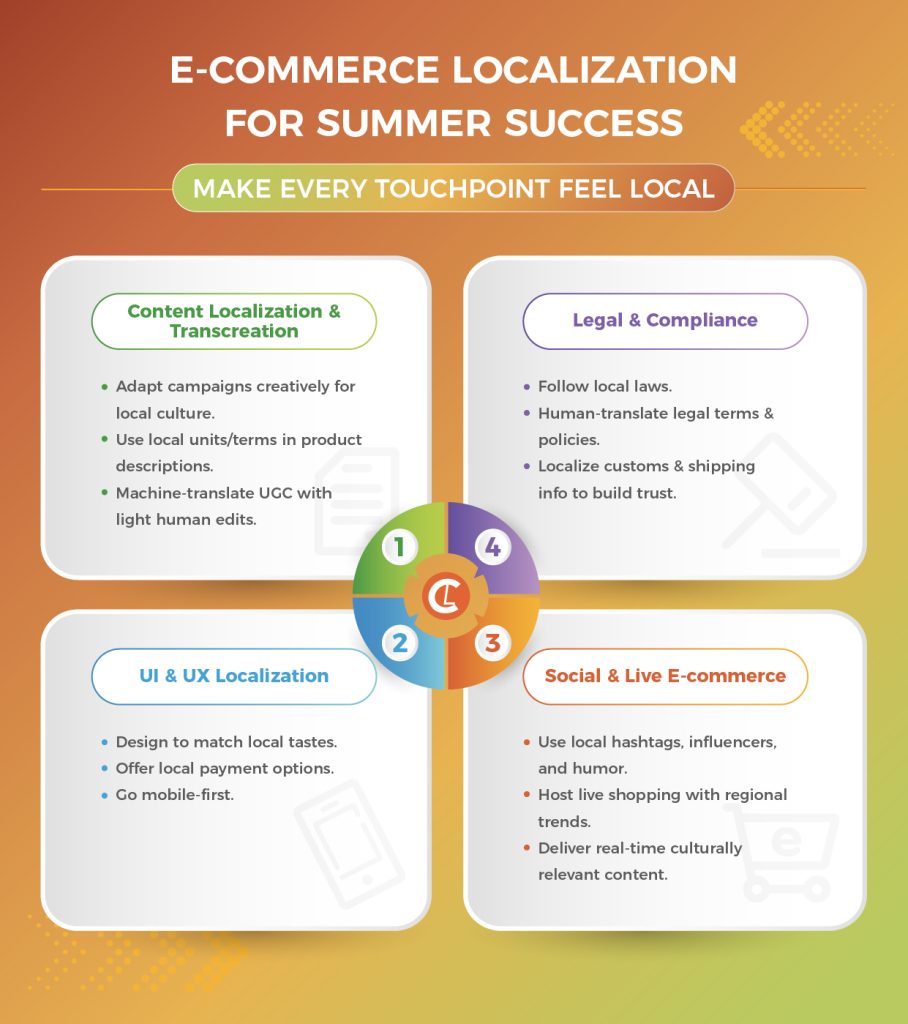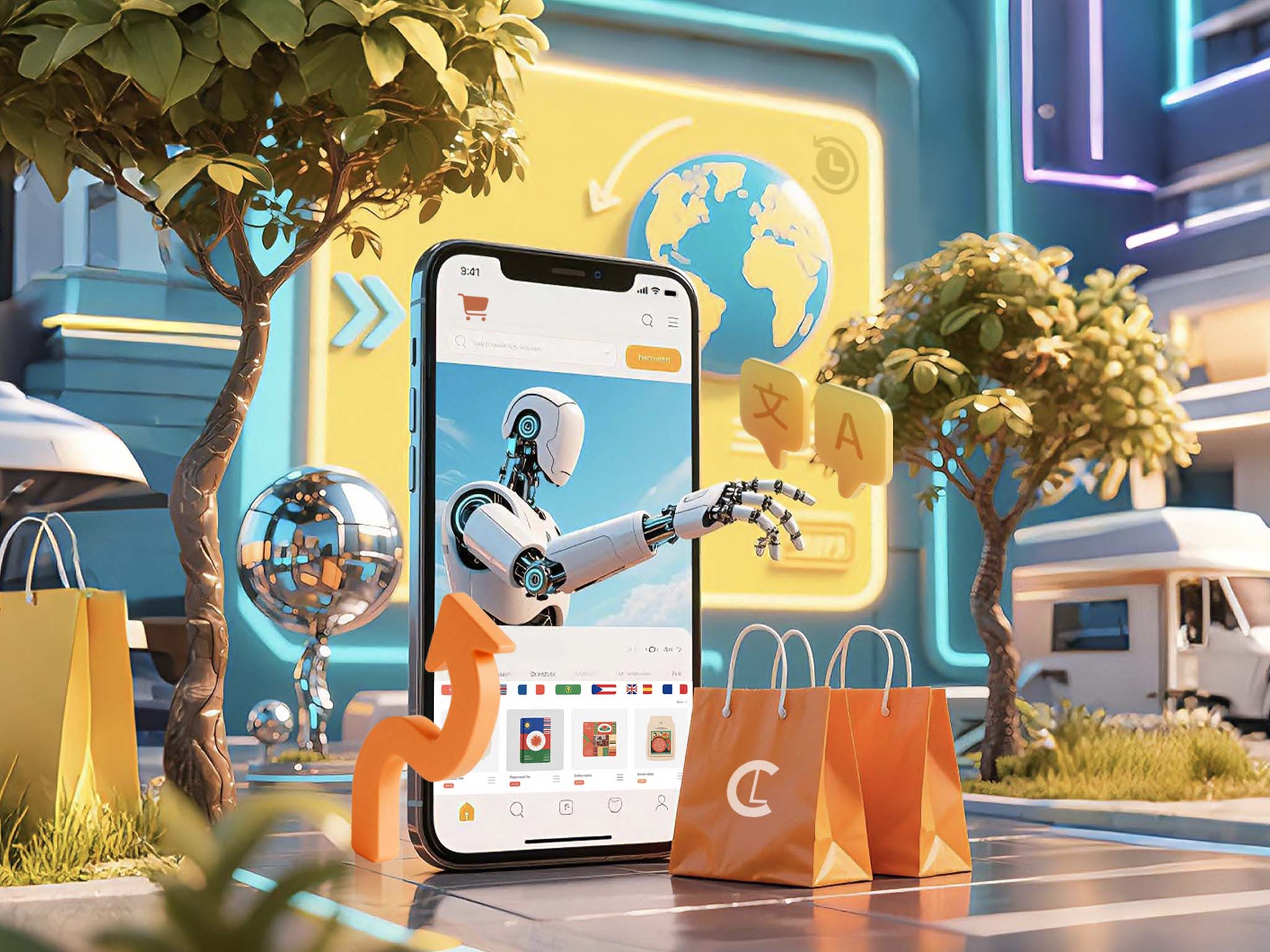Summer sparks a frenzy of consumer spending, from sun-soaked beachwear to festival gear and travel essentials. With the global e-commerce market valued at USD 19–28 trillion and growing at a 15–19% CAGR, the season offers a massive opportunity for brands to connect with international shoppers. But here’s the thing: a generic campaign won’t cut through the noise.
Localization is the key to turning clicks into sales. Research shows 90% of global consumers ignore products not in their native language, and 70% choose their own language over English. As summer heats up the competition, let’s dive into how e-commerce brands can localize campaigns to captivate global audiences and boost revenue.
Understanding Regional Summer Behaviors and Preferences
Summer isn’t the same everywhere, and understanding these differences is the first step to winning over global shoppers. From cultural festivals to economic realities, consumer behavior varies wildly, and brands need to tune in.

In the Asia-Pacific, where China alone drives over USD 1 trillion in e-commerce revenue, summer ties to vibrant events like the Dragon Boat Festival or India’s monsoon sales. India’s 122 major languages and projected 1.1 billion wireless users by 2025 demand hyper-local campaigns—think Mumbai-specific ads with mobile-first designs and cash-on-delivery options, a hit in Southeast Asia’s fast-growing markets (10–25% yearly growth).
Over in the U.S., a USD 1 trillion powerhouse, summer means Independence Day barbecues and back-to-school prep, with shoppers craving fast delivery and clean, minimalist websites.
Europe, generating USD 630–700 billion, sees summer as peak travel season, but Central and Eastern Europe’s 23–24% growth by 2026 requires navigating linguistic complexities like Czech’s gendered grammar.
Latin America, on track for USD 1 trillion by 2027, pulses with Carnival-driven purchases in Brazil, where MercadoLibre thrives on local payment options like Pix.
In the Middle East and Africa, with over 500 million users by 2025, mobile rules: 68% of UAE revenue comes from phones, and platforms like Jumia lean on localized solutions like cash-on-delivery.
This brings us to generational and cultural nuances.
Gen Z and Millennials (25–40) live on mobile apps and social media, drawn to personalized experiences like Vinted’s AI-driven product feeds. Boomers and Gen X, however, stick to desktops, valuing clear descriptions and secure transactions. Culturally, Japan’s collectivist shoppers follow group trends, while U.S. consumers prioritize personal choice. Trust also varies: low-trust markets like Brazil need robust refund policies and secure payments to ease fears of cart abandonment, unlike high-trust Nordics.
Localization Strategies for E-commerce Success
Localization is about making every touchpoint feel like it was made for the local shopper. Let’s explore how brands can craft summer campaigns that hit the mark.

1. Content Localization and Transcreation
Content is the backbone of any summer campaign, from promotional emails to product descriptions. However, literal translations often fail to capture cultural nuances or seasonal relevance. Transcreation—adapting content creatively to resonate with local audiences—is essential for high-impact content like marketing campaigns.
- Marketing Content: Summer campaigns should align with local events and holidays. For example, Adidas localizes its global brand content into over 40 languages, using in-market linguists to ensure tone and style reflect regional preferences. In Japan, a summer campaign might highlight lightweight sportswear for humid weather, while in Brazil, it could focus on vibrant designs for Carnival. Human translation and transcreation are critical for advertisements, landing pages, and social media posts, ensuring cultural relevance and emotional resonance.
- Product Descriptions: Accurate, culturally adapted product descriptions are vital for summer products. For instance, a swimsuit’s size chart must use local measurement units and terminology should reflect local preferences (e.g., “bikini” vs. “swimsuit”). Companies like Shopify use AI tools like Shopify Magic to generate SEO-optimized product descriptions, which are then reviewed by human editors to ensure cultural fit.
- User-Generated Content (UGC): UGC, such as product reviews, is often deprioritized for full localization due to volume. However, machine translation (MT) can improve discoverability.
2. User Interface (UI) and User Experience (UX) Localization
A localized UI/UX ensures that websites and apps feel intuitive and trustworthy. For summer campaigns, this means tailoring navigation, checkout flows, and visual design to local expectations.
- Website Design: Visual preferences vary by region. Asian markets like Japan and China prefer information-heavy, visually packed designs, while the U.S. and Europe favor minimalist layouts. For example, a summer campaign in China might feature bright, animated banners for a festival sale, while a U.S. campaign could use clean, simple imagery to highlight outdoor gear.
- Checkout and Payment Flows: Payment localization is critical to reducing cart abandonment. In Poland, offering BLIK and debit card payments is essential, while in Brazil, Pix and boleto bancário are preferred. A 2020 study of 450 European e-commerce websites found that lack of translation on checkout pages was the most common error, leading to lost sales.
- Mobile Optimization: With mobile commerce driving significant revenue in regions like the Middle East and Southeast Asia, summer campaigns must prioritize mobile-first designs. Platforms like Jumia tailor their mobile interfaces to offer cash-on-delivery options, addressing regional preferences and boosting trust.

3. Social and Live E-commerce
Social e-commerce platforms like TikTok and Instagram are transforming summer shopping, particularly among Gen Z and Millennials. Live e-commerce, popularized in China through platforms like Taobao Live, is also gaining traction globally. Localizing these channels requires real-time, culturally relevant content.
- Social E-commerce: TikTok Shop and Instagram’s shoppable video content rely on localized hashtags, influencers, and humor. For example, a summer campaign in Southeast Asia might feature local influencers showcasing beachwear during live shopping events, using region-specific slang and trending challenges to drive engagement.
4. Legal and Compliance Localization
Summer campaigns must comply with local regulations, such as the European Accessibility Act (effective June 28, 2025), which mandates accessible online experiences for users with disabilities. Legal content, including terms of service, privacy policies, and return policies, requires human-in-the-loop translation to ensure accuracy. For cross-border sales, localizing customs clearance and shipping information is equally important to avoid delays and build trust.
Data-Driven Personalization and Seasonal Campaigns
Personalization is the next frontier of localization, enabling brands to deliver hyper-relevant summer experiences that resonate with individual consumers. By leveraging AI and data, brands can tailor campaigns to align with regional trends, consumer behaviors, and personal preferences, driving higher engagement and conversions.
The Power of AI-Driven Personalization
AI is transforming e-commerce by enabling hyper-personalized experiences. For summer campaigns, this means using data to customize product recommendations, marketing messages, and user journeys.
- Personalized Recommendations: Platforms like Vinted and Zalando use AI to tailor product feeds based on user data (e.g., size, style, location). Zalando’s Trend Spotter feature analyzes search and cart data to provide weekly style updates for 10 European cities, aligning with summer fashion trends. Similarly, Amazon’s recommendation engine drives 35% of its sales by suggesting products based on browsing and purchase history.
- Dynamic Content: Netflix personalizes thumbnails for summer movie recommendations, using AI to select images that resonate with individual viewers. For example, a user who enjoys Uma Thurman films may respond well to Pulp Fiction artwork featuring her, while a John Travolta fan might be more drawn to artwork highlighting him.

- Voice Search and Chatbots: Voice commerce and AI chatbots are gaining traction, especially for younger demographics. Shopify’s Sidekick and Bank of America’s Erica chatbot handle customer queries in local languages, improving accessibility and reducing friction. For summer campaigns, chatbots can suggest seasonal products (e.g., sunscreen, travel gear) based on user intent and location.

Balancing Speed and Quality
For summer campaigns, where time-sensitive promotions are critical, brands must balance speed and quality. Fast-paced content like flash sales can use MT with light post-editing, while brand-driven content like campaign slogans requires human transcreation. Clearly Local’s Smart Engine, for example, automates engine selection across 30+ providers, optimizing for latency, cost, and quality based on content type.
Overcoming Data Challenges
Effective personalization requires clean, centralized data. Translation memories, glossaries, and market-specific notes must be organized to feed AI models accurately. Content profiles—machine-readable bundles of audience, tone, and compliance data—enable LLMs to generate nuanced, context-aware content. For example, a content profile for a summer campaign in Japan might specify a youthful tone, emoji usage, and alignment with local festivals.
Make This Summer Count
Summer is your brand’s chance to shine worldwide. By tapping into regional behaviors and cultural nuances, you can craft campaigns that feel native, relevant, and irresistible. Ready to make your summer strategy truly global?



